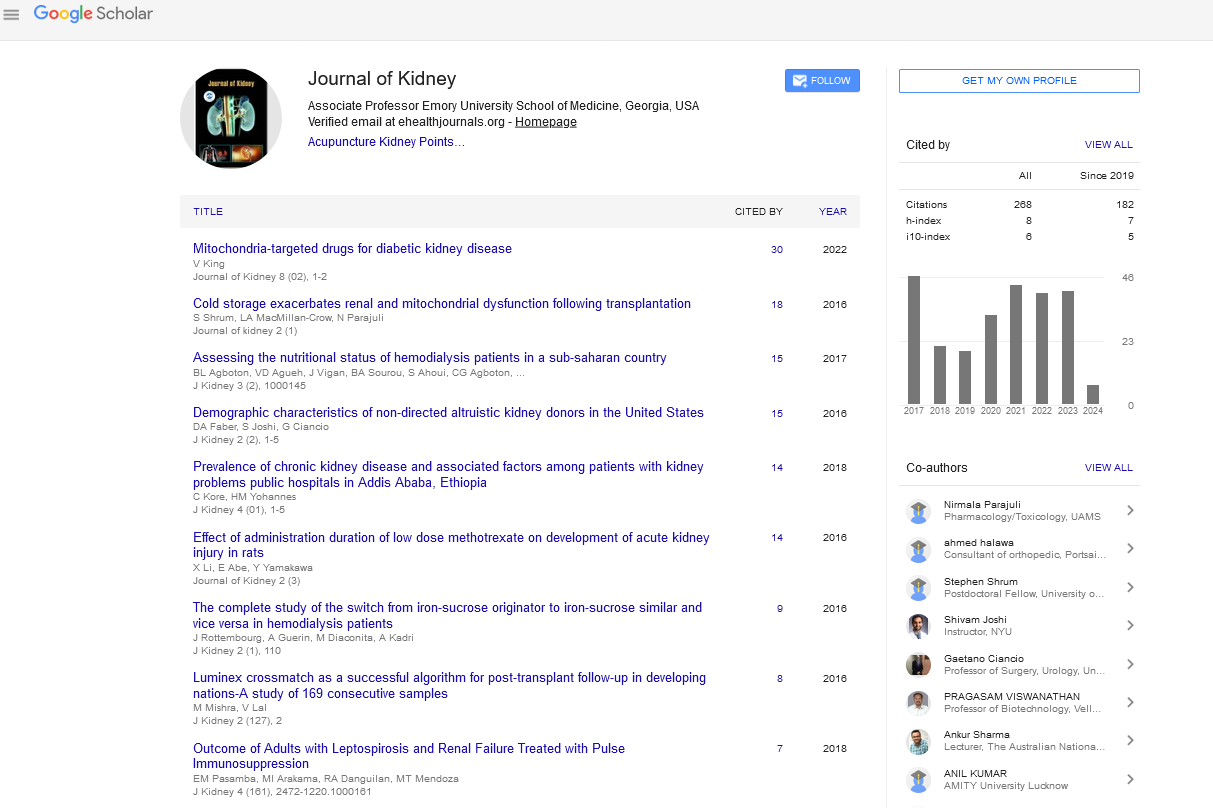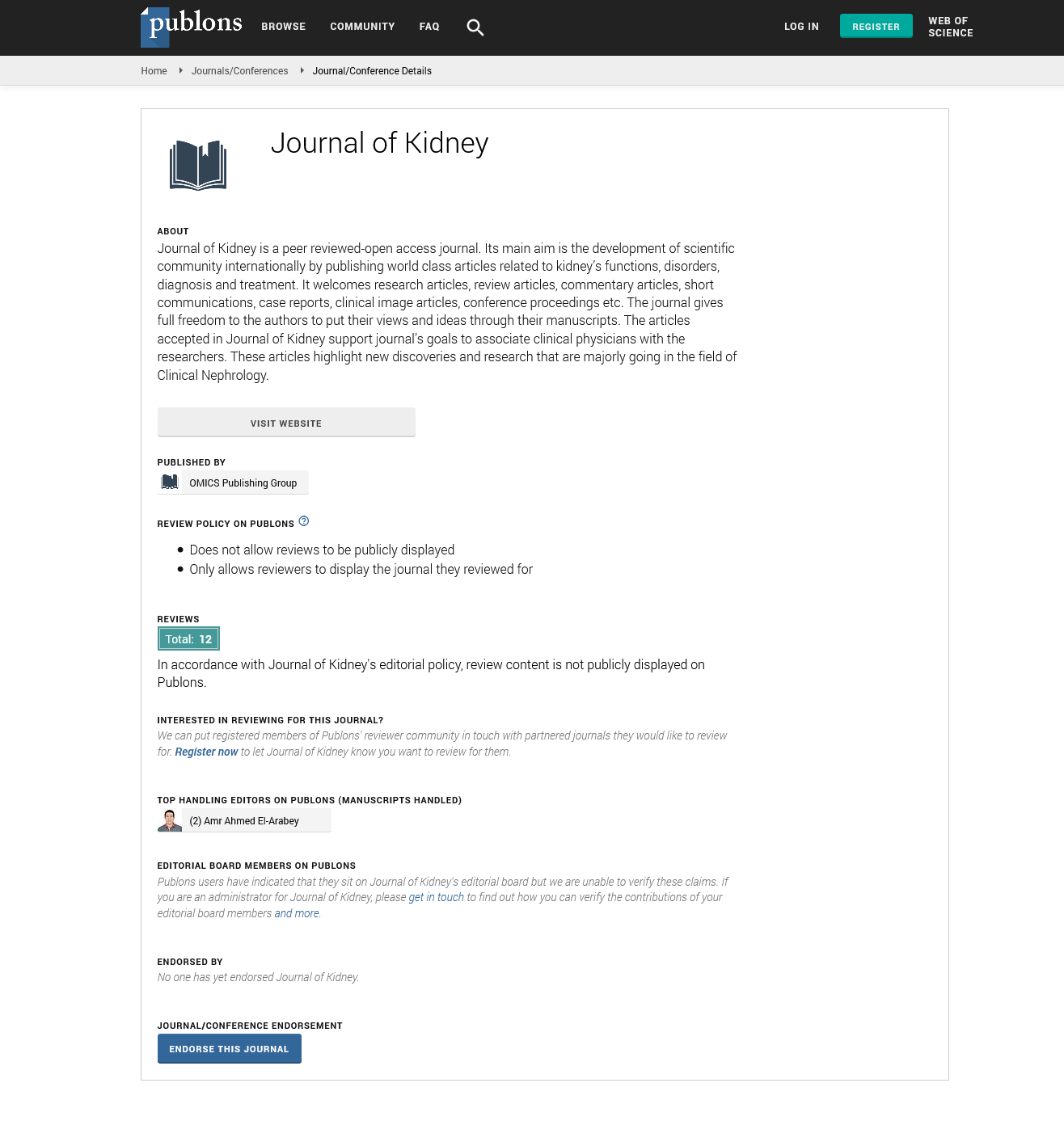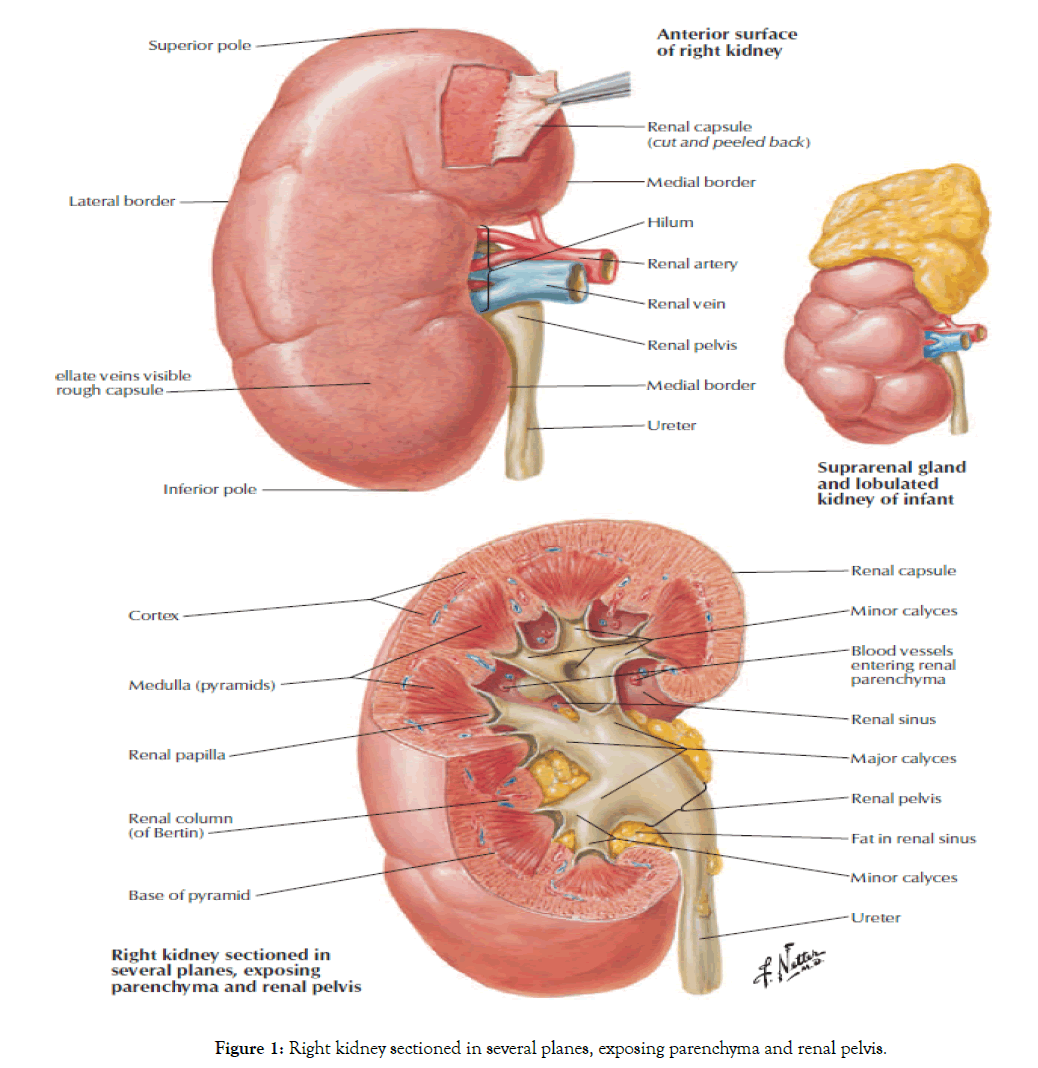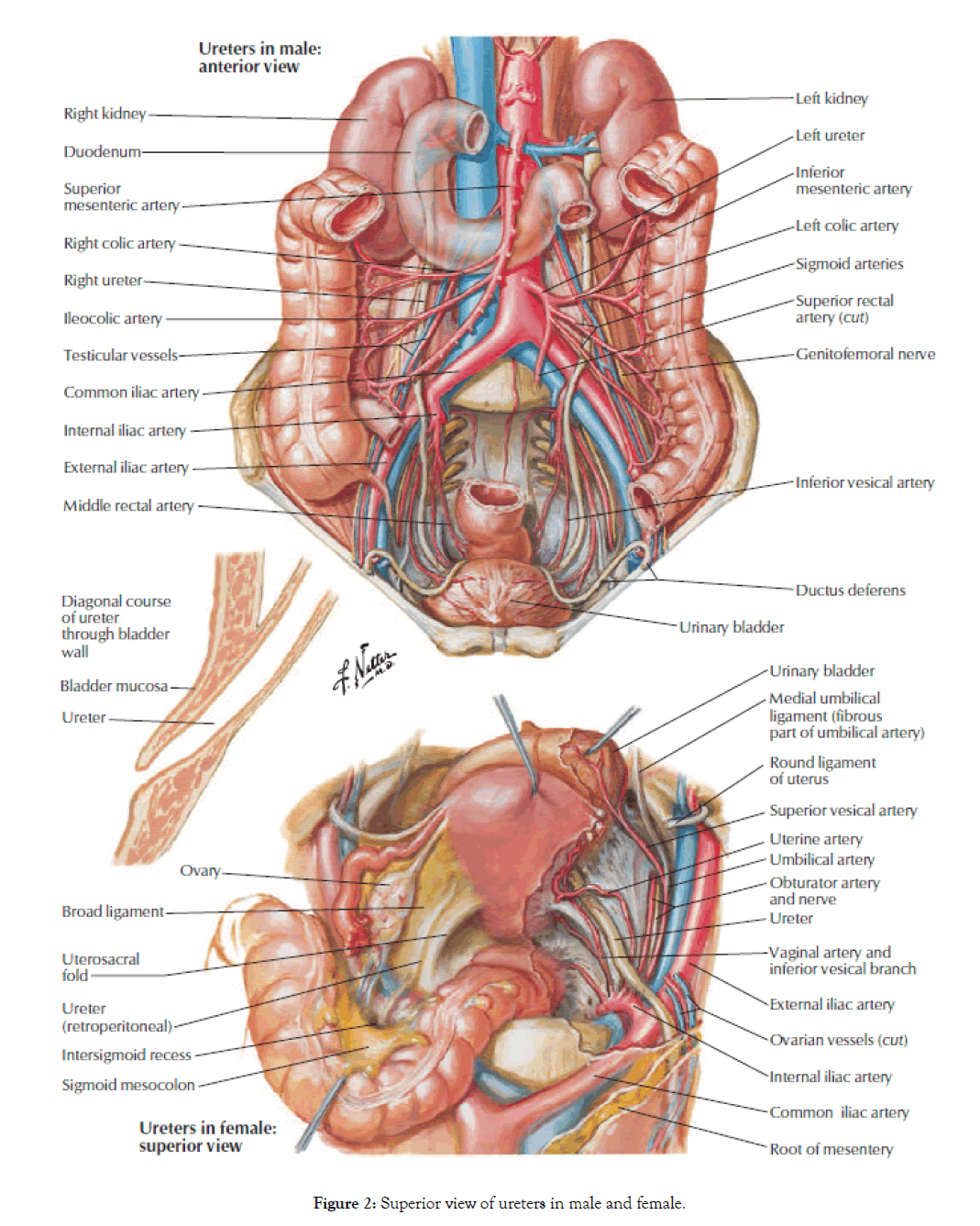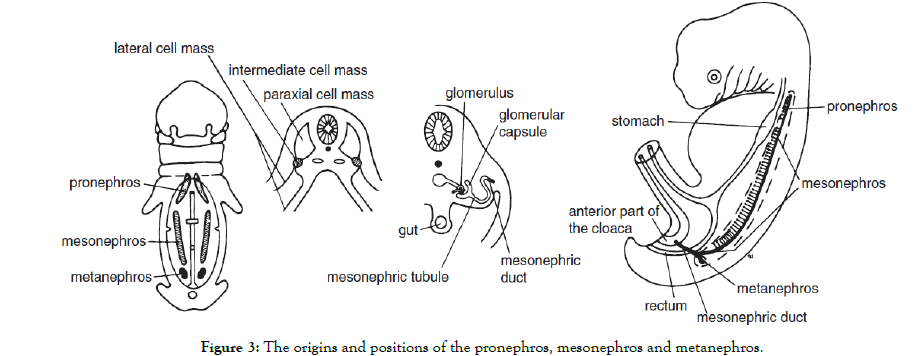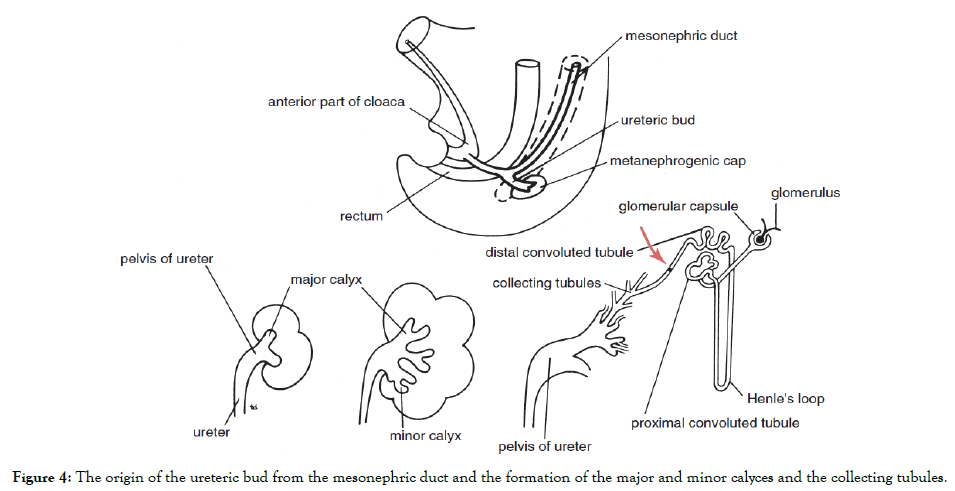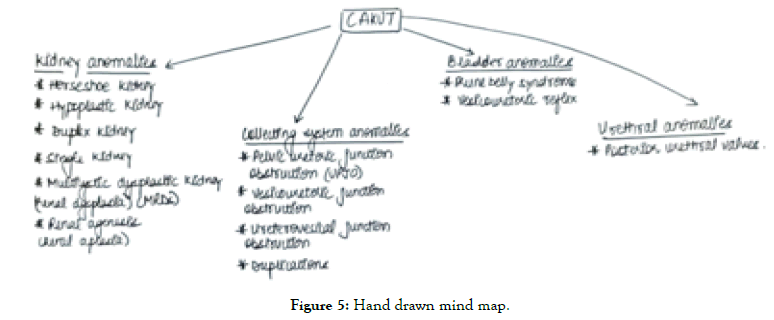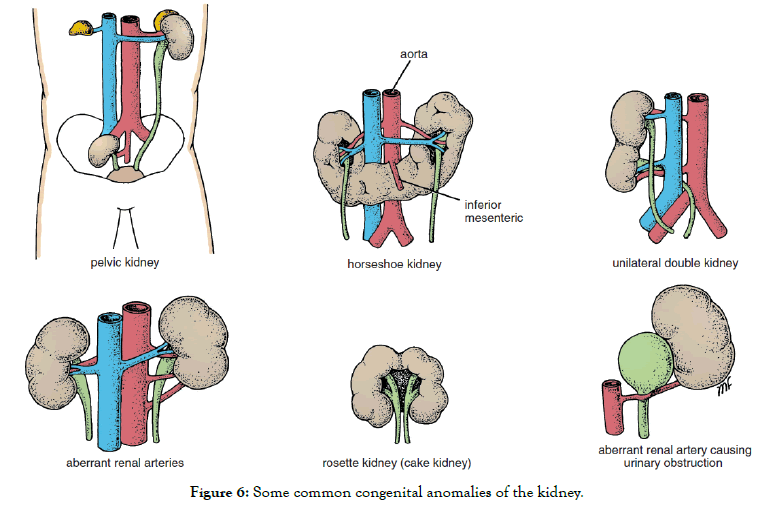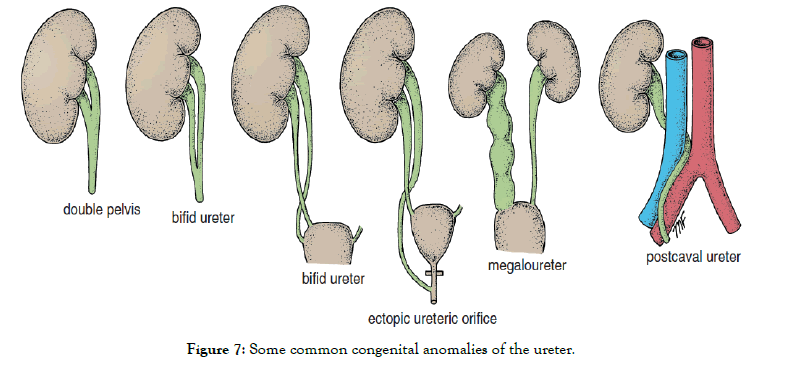Indexed In
- SCOPUS
- RefSeek
- Hamdard University
- EBSCO A-Z
- OCLC- WorldCat
- Publons
- Google Scholar
Useful Links
Share This Page
Journal Flyer

Open Access Journals
- Agri and Aquaculture
- Biochemistry
- Bioinformatics & Systems Biology
- Business & Management
- Chemistry
- Clinical Sciences
- Engineering
- Food & Nutrition
- General Science
- Genetics & Molecular Biology
- Immunology & Microbiology
- Medical Sciences
- Neuroscience & Psychology
- Nursing & Health Care
- Pharmaceutical Sciences
Mini Review - (2021) Volume 7, Issue 12
Congenital Anomalies of Kidney and Urinary Tract (CAKUT)-Literature Review
VK ChimurkarReceived: 06-Dec-2021 Published: 27-Dec-2021
Abstract
Kidneys as well as urinary tracts are the major excretory organs of the human body and removes waste products of protein metabolism. They also remove surplus water and salts from the blood. Kidneys as well as urinary tracts also important for survival as they are crucial for preserving the fluid-electrolyte balance of the body tissue fluids. The inaccuracies in the embryogenesis of the outflow tracts along with the kidneys are vulnerable to the environmental endangerments and disturb the development throughout gestation. Mutations in the patient with CAKUT are responsible for the chronic renal diseases in the 1st three decades of life. Fetus dose not survive in severe cases of CAKUT as a result of non-formation of kidneys and outflow tract, but in less severe cases there are more chances to survive and may identified in adulthood. Though the critical cases of CAKUT are infrequent, marginal nephron number is considerably frequent disorder exerting its effect on renal functions with increasing age. Congenital anomalies of kidney and urinary tract have a wide range of abnormalities inclusive of fatal agenesis of both the kidneys and asymptomatic ectopic kidneys. Hence patient with the solitary kidney should follow-up regularly for better and close monitoring. The clinical presentation of CAKUT along with its long term outcomes and epidemiology is covered in this review. With a comprehensive knowledge of the roots of CAKUT and marginal nephron numbers, identification of preventive treatment and establishment of clinical guidelines for the patients can be begun. Comprehension of relevant endangerments and changes in the epidemiological trends especially modified maternal factors and delivery services is vital for prompt detection and prediction of prognosis in the course of pregnancy due to subsequent morbidity and mortality as a result of the presence of CAKUT.
Keywords
Outflow Tracts; Congenital Anomalies of Kidney and Urinary Tract; Gestation; Neuroblastoma; Dysplasia
Introduction
Congenital anomalies of the kidneys and urinary tracts (CAKUT), which constitute two in ten of the congenital deformities observed in 0.2% of all live births, are disorders attributable to the flaws in renal embryogenesis along with their efflux tracts [1,2]. Week 3 of the gestation period marks the beginning of the formation of the kidneys and nephrogenesis doesn’t stop until 36th week, hence, the kidneys and efflux tracts are vulnerable to environmental endangerments that disrupt embryogenesis during the course of pregnancy [1]. Several units of heredity incriminate renal embryogenesis as well as mutations are recognized CAKUT patients, the typical cause in the first three decades of life of chronic kidney disease [1,3]. The fetus does not survive in severe cases of CAKUT as a result of non-formation of kidneys whereas there is a chance of survival, in cases of less severity, with efflux tract plus kidney defects or maybe noted in adulthood [1]. It is noted that morbidity from CAKUTs may not be observed up until adulthood hence patients with a solitary kidney should follow up regularly for better and close monitoring, ideally for the duration of their life [4].
Gross anatomy of the urinary system
The two fabi form reddish brown organs located at the rear end of the peritoneum flanking both lateralities of the backbone of the posterior abdominal wall opposite T12–L3 vertebrae.
They are the major excretory organs and are thus vital for maintaining the osmolarity of the fluids of the tissues of the body and hence for survival.
The right side presence of the liver is the reason behind the slight beneath placement of the right kidney in comparison to the left.
The top portion of the hilum of the right kidney is transversed by the trans pyloric plane which also passes through the bottom portion of the hilum of the left one.
Each kidney presents with a hilum, two borders (medial and lateral), two poles (superior and inferior) and two surfaces (anterior and posterior) as its external features.
Hilum-Hilum, a profound upright slit present on the central part of the medial border of each kidney, transmits the following structures in a before backward fashion:
1. Renal vein.
2. Renal artery.
3. Renal pelvis.
4. Subsidiary branch of renal artery.
Furthermore, nerves, sympathetic and primarily vasomotor in nature, and lymphatics pass through the hilum as well (Figure 1,2) [5,6].
Figure 1: Right kidney sectioned in several planes, exposing parenchyma and renal pelvis.
Figure 2: Superior view of ureters in male and female.
Epidemiology
Congenital anomalies of kidney and urinary tract have broad spectrum abnormalities inclusive of fatal bilateral renal agenesis as well as asymptomatic ectopic kidneys [7]. Majority of CAKUT are revealed in the antepartum or immediate postpartum period with a notable part, with severity of variable magnitude, ascertained in the adult population [7]. The sonographic detection of unselected population reported the prevalence of CAKUT to be between 0.1 to 0.7 percent [8]. In cases of live and still born infants, CAKUT incidence rate is 0.03 to 0.16 percent and the incidence of nonrenal anomalies in infants with CAKUT was noted in 30 percent of such cases. By coalescence of CAKUT and non-renal anomalies, over 200 syndromes are described [9]. The principal root of endstage renal disease (ESRD) in paediatric age group is CAKUT which furthermore ensues difficulties of the excretory system as adults like nephrolithiasis, inflammation, high blood pressure, and renal failure [7]. It was concluded, after a thorough investigation of chronic renal disease cases worldwide, that roughly 30- 50% of all the cases are due to CAKUT and that hardly any of these anomalies can predispose to adult-onset diseases [10]. All over the world cases of end-stage renal disease in 40% to 50% of paediatric and 7% of adult patients are recognized as a manifestation of CAKUT [2].
Chevalier RL elaborate, in 2009, the various parameters that need to be closely monitored in CAKUT patients of paediatric age group. These parameters include diet and nutrition, growth, blood pressure, serum creatinine and proteinuria (better phrased as microalbuminuria); this may include renal imaging as per the need. Serum creatinine and proteinuria are relatively insensitive determinants in this age group because majority of the cases of end-stage renal disease are a manifestation of tubule interstitial rather than glomerular disorders. Therefore, the need for a better comprehension of the natural history of such demanding disorders arises as they can have an impact on the entire life cycle of the being. Hence we require new biomarkers with greater sensitivity and specificity to follow changes in renal status before they become irreparable [4].
In 2012, Caiulo VA, et al. collected and analysed data in which 171 CAKUT (frequency was 0.96%) were spotted during largescale screening. The prevailing renal abnormality found was vesicoureteral reflux (n = 39), next in line are ureteropelvic junction obstruction (n = 33), ectopic kidney (n = 26), and renal dysplasia (n = 19). Furthermore, nephrogenic rests (n = 2), inclusive of a number of extra-renal pathologies, together with abdominal neuroblastoma (n = 3), were diagnosed incidentally [1].
In the year 2013, Mnari W et al. stated that CAKUT are a frequent finding in paediatric age group and are a noteworthy root of morbidity in early childhood. Consequently, for an accurate diagnosis and appropriate management a better strategy and knowledge of urologic anomalies are crucial [11].
In 2014, dos Santos Junior AC et al. put in a nutshell the plausible tools by which genes in charge of renal embryogenesis are probably responsible for development of CAKUT [10].
In line with the study published in 2015, Nicolaou N et al. demarcate the auxiliary environmental endangerments and hereditary influences on CAKUT and deliberate about the difficulties and plan of action used to give a dissertation to the participation and interaction of these agents in the development of the disease [12]. In conjunction with the study published in November 2015, Simões AC et al summarize in their findings, with reference to foremost year of being, the prevalence of urinary tract infection. It was reported that cases of UTIs were observed more in males (3.7%) in comparison to females (2%). Signs together with the symptoms of UTI are indifferent, particularly in young children; in many cases, fever being the solitary symptom [13]. In keeping with the data published in Aug 2015 by Vivante A et al, human CAKUT are a result of the mediating of TBX18 transcriptional repression with dominant negative TBX18 mutations, thus compromising with the development of unstriated muscle cell in the ureter leading to development of human CAKUT [3].
Ramanathan S et al. highlight in their study published in February 2016 that congenital anomalies of kidney and urinary tract have several types of abnormalities including fatal agenesis of both the kidneys as well as asymptomatic ectopic kidneys. The earliest imaging performed, due to its easy availability, free of radiation and non-invasive used both in antepartum and postpartum, is US in routine clinical practice. MRI together with CT are required to ascertain the abnormality spotted in ultrasound, identification of multiplex malformations, illustration of vascular as well as collecting system anatomy and prompt ascertation of complications like nephrolithiasis, inflammation as well as malignancies [7]. The comprehensive knowledge of the imaging attributes of huge spanse of renal anomalies along with associated complications is of paramount importance to the radiologist which will be used in prompt diagnosis and fitting management. In a population based case control study in 2016 by Tain et al stated that CAKUT are linked with many maternal health endangerments. Development of executive well-rounded guidelines for prepartum counselling and care of women having the likelihood of un toward reproductive outcomes is the need of the hour to check and avert kidney disease progression and diminish complications. This is strongly supported because Taiwan is known to have maximum rate of incidence and rampancy of end-stage renal disease worldwide [14].
As per the thoroughly researched study of April 2017, Capone VP crisply state the genetic picture of CAKUT as well as the future standpoint of the hereditary bases of the same [15].
In 2018, Vieira M et al ponder that the primary source of chronic renal disease in paediatric population is CAKUT. As a good nephrologist, good command over these pathologies allows a flow of nephrological followâ??up from paediatric to adult care services when such patients are shifted to adult units; plus, it is vital to sustain an unceasing joint effort between adult and pediatric units [16]. Perlman S in Feb 2018, deliberated on their findings based on a study group of 83 foetuses: 35 foetuses presented with isolated severe hydronephrosis and 48 with associated CAKUT. 22.6 ± 8.5 mm (range 15.0â?66.0 mm) was noted to be the mean anteriorâ?posterior renal pelvic diameter. The juxtaposition of isolated severe prenatal hydronephrosis and CAKUT group was studied. The CAKUT group was found linked with an appreciably increased incidence of postnatal need for surgery (17.6% vs 44.2%, P = .014), dysplastic kidney (0% vs 14%, P = .023), and total abnormal outcome (52.9% vs 86%, P = .001) [17].
In 2019, Talati AN et al. address the monogenic origins of CAKUT, affiliated ultrasound features, and reflections for hereditary diagnosis and management, both at antenatal and postnatal levels [2].
In April 2020, Okoronkwo et al stress that the incidence of CAKUT is notable. The chief CAKUT were anomalies of the urethra while bladder anomalies were noted minimally. The paediatric prevalence of VUR in South African origin is marginal compared to that of first world nations. Regular medical follow-up of children with CAKUT should be done to avoid early and late complications [18]. In a study in 2020 by Wu CH et al. on “Phenotype expansion of heterozygous FOXC1 pathogenic variants toward involvement of congenital anomalies of the kidneys and urinary tract (CAKUT)” stated that extension of FOXC1 phenotype of pathogenic variants may be employed to explain allelism toward involvement of CAKUT [19]. According to a study published in ‘The Indian Journal of Pediatrics’ 2020 which involved screening for anomalies of kidney and urinary tract of asymptomatic first degree relatives of children with CAKUT, familial clustering was pinpointed in 7.9% out of the 138 families (of the index cases) screened. Furthermore, in majority of the cases the anomalies noted were in disagreement with the index anomaly [20].
The 2021 study by Kohl S et al, emphasises on the importance of establishment, in cases of monogenic CAKUT, a molecular genetic diagnosis which will aid the families of such patients to better comprehend the etiological basis of the affected child’s diseased state. In addition to that it may open up the reality of a patient centered care as well as empower the physicians to classify it to the highest achievable accuracy [21]. The 2021 study by Stankovic A. stressed on the need for research on CKD biomarkers with respect to CAKUT. It is advisable to intensify the fore mentioned research bearing the multifactorial models of predictions which must be inclusive of replicate studies Such endeavours should empower national registries to authorize follow-up as well as prevail over boundaries of the road to authentication and implementation of clinical biomarkers [22]. In 2021, Okoronkwo NC concluded that in children, the number of cases of urinary tract infection were more in those with CAKUT than in the general paediatric population. He also stated that recurrent UTI due to CAKUT probably acts as a predisposing factor in children to renal scarring, high blood pressure and CKD. Thus emphasis is laid on the prevention of UTI in this group, but achieving this has become a medical challenge in view of the controversy surrounding use of prophylactic antibiotic which was found to be efficacious in reducing, that cohort of patients with CAKUT, the rate of UTI [23].
Embryology
The excretory system: The development of the excretory system starts preceeds that of the genital system and includes the kidneys, a pair of ureters, a urinary bladder and a urethra [24].
Kidneys and ureters: The pronephros, mesonephros and metanephros are the three structures that come into view. Out of these three, the metanephros is in charge of the development of the permanent human kidney. The ureteric bud via the mesonephric duct and the metanephrogenic cap via the intermediate cell mass of mesenchyme of the lower lumbar and sacral regions is responsible for the development of the metanephros.
Figure 3: The origins and positions of the pronephros, mesonephros and metanephros.
Figure 4:The origin of the ureteric bud from the mesonephric duct and the formation of the major and minor calyces and the collecting tubules.
Ureteric Bud: The protuberance of the mesonephric duct is the ureteric bud (Figure 4 and 5). The ureter develops from the ureteric bud and then goes on to expand at its apex thus leading to the formation of the renal pelvis. The major calyces are the branches given off by the renal pelvis and the minor calyces, as well as the collecting tubules, are the branches of the major.
Metanephrogenic Cap: The capsule of the glomerulus, the convoluted tubules (both the distal and proximal) as well as the loops of Henle are a result of the condensation of the metanephrogenic cap about the ureteric bud (Figure 5). The invagination, by a network of capillaries, of the capsule of the glomerulus occurs leading to glomerulus formation. The collecting tubule, derivative of the ureteric bud, is joined by both the distal convoluted tubules, derivative of the metanephrogenic cap. The lobulation of the renal surface which is present at the time of birth starts disappearing shortly after. The middle sacral artery, the perpetuation of the aorta in the pelvic region, provides the arterial supply to the developing kidney which is a pelvic organ at first and later makes its way up the posterior abdominal wall. The maturation of the body in the lumbosacral regions and the upright alignment of the curvature is responsible for the ‘ascent of the kidneys’. Side-by-side elongation of the ureter takes place.
Figure 5:Hand drawn mind map.
Progressively superior lateral splanchnic arteries, branches of the aorta, vascularize the kidneys. Level of 2nd lumbar vertebra is the ultimate situation of the kidney. The right side presence of the liver is the reason behind the slight beneath placement of the right kidney in comparison to the left [25].
With the ascent of the kidney, now only the aorta provides the arterial supply. The most crucial events in the urinary tract embryological timeline are:
1. End of 5th week-ureteric bud development from the mesonephric duct.
2. 6th Week-Union of the mesonephros and ureteric bud.
3. 6th-7th Week-Ascent of the kidneys.
Duplication, agenesis or hyplasia anomalies are a result of any abnormality occurring in the first two stages. Additionally, ectopic situation of the kidney or fusion abnormalities are due to any aberrance from the usual order in the third stage [24].
Congenital Anomalies of Kidney and Urinary Tract (CAKUT)
Congenital anomalies of kidneys and urinary tract are classified as seen in the mind map.
Categorization on the basis of embryology can be made into three broad categories:
1. Flaw in the development of the parenchyma of the kidney;
2. Deviation from the usual sequence of migration; and
3. Flaw in collecting system development [7].
The disturbance in the embryologically expected migration of the kidneys leads to frequent congenital anomalies of the kidney and urinary tract (CAKUT), renal fusion and ectopy. The usual trend observed in paediatric population with these abnormalities is asymptomatic presentation yet some present with symptoms as a result of complications, for example infection, kidney stones, and obstruction of the urinary tract [26].
Polycystic Kidney: It can be inherited from by either parent. It presents as cysts of congenital origin in the hepatic, pancreatic and pulmonary tissues. There is boundless growth of both the kidneys which are also perforated with numerous cysts. Flaw in joining of collecting and immature convoluted tubules lead to this condition. Retention cysts are formed due to urine accumulation in the proximal tubules.
Pelvic kidney: The arrest in the usual ascent, commonly at the pelvic brim results in pelvic kidney (Figure 6). It may have an asymptomatic presentation with normal functionality. Cases of inflamed presentation due to its abnormal situation- of an ectopic kidney, are normally a mistaken diagnosis.
Horseshoe kidney: Horseshoe kidney comes into existence due to the fusion of the caudal ends of the two kidneys during development (Figure 6). The ultimate situation of the kidneys in the lower part of the lumbar region is due to the entrapment of the interconnecting bridge at the back of the inferior mesenteric artery during their ascent from the pelvic region. Infection and calculi formation may be a manifestation of the urinary stasis due to kinking of the pair of ureters in the course of their passage inferiorly over the bridge of tissue of the kidney. This condition may be corrected surgically by dividing the bridge.
Figure 6:Some common congenital anomalies of the kidney.
Unilateral double kidney: Presence of two kidneys on one side with separate blood vessels and ureters is what is popularly known as ‘unilateral double kidney’. The top extremity unites with the bottom extremity and ureteric bud on one periphery traverses the center line at the time of its ascends, of a kidney of normal situation (Figure 6). In this anomaly as well kinking of the ureter results in urinary stasis and thus the need for surgical intervention.
Rosette kidney: Union of the two kidneys takes place at their hilum and are found situated in the pelvis. They, jointly, form a rosette which is a result of the prefusion of the pair of ureteric buds (Figure 6).
Supernumerary renal arteries: They are comparatively frequent, noted as resolute fetal renal arteries originating in an order from the aorta for the vascularization of the kidney during its ascent from its pelvic situation. They may ultimately result in a condition known as hydronephrosis which is a dilatation of the pelvis as well as the calyces due to urinary stasis as a manifestation of the crossing of the pelviureteral junction by a supernumerary artery (Figure 6). Hence this anomaly draws clinical attention.
Double pelvis: Generally unilateral (Figure 7), this anomaly is due to partition of the ureteric bud before time close to its termination. The drainage of the upper cluster of calyces is taken up by the upper pelvis and that of the middle and lower clusters by the lower pelvis, lower being larger in comparison to the upper pelvis.
Figure 7:Some common congenital anomalies of the ureter.
Bifid ureter: The pair may unite in the lower one-third of their route or may open via a common opening into the bladder or may open as individual entities into the bladder (Figure 7). In the lastmentioned scenario, one passes over the other paving the way to urinary obstruction. The division of the ureteric bud before time is the reason behind the existence of bifid ureter. On radiological investigations, there exists a mere chance of spotting dual number of ureters and ureters. The likelihood of a bifid ureter becoming infected or be the site of stone formation is more than that of a normal ureter.
Megaloureter: It may present with laterality, uni or bi, and with total absence of motility with an idiopathic cause (Figure 7). The ureter becomes prone to infection due to accumulation of urine. Surgical intervention, of the speciality of plastic surgery, is crucial to revamp drainage rate.
Postcaval ureter: Obstruction of the right ureter by the inferior vena cava in case of the former’s ascent posterior to the latter (Figure 7). The preferred treatment is surgical intervention by rerouting of the ureter along with reimplantation of the distal end into the bladder [25]. The impact of environmental as well as epigenetic variables on natural history of CAKUT together with renal development is held up by several studies, thus drawing the conclusion of multifactorial pathogenesis of this syndrome [17].
Detection of CAKUT
CAKUT are variable thus may show their effects on the kidney(s) alone and/or the lower urinary tract making radiological intervention indispensable. The assessment of children with a urinary tract abnormality query is clarified by the employment Ultrasonography (US), best suited modality for this purpose. The evaluation of the anatomy and abnormalities of the bladder and urethra is done using Voiding Cystourethrography (VCUG) which in turn also determines which additional examinations are needed: Intravenous Urography (IVU), CT scan or MR imaging. One of the most crucial diagnostic tools in the assessment of neonates with hydrouretero nephrosis is 99mTc-DTPA dynamic renal scintigraphy [17]. The principal radiological modalities employed in the detection of various CAKUT are ultrasonography, magnetic resonance imaging and computed tomography [7]. The majority of CAKUT are spotted by routine antenatal ultrasonography in gestational period [8]. An outstanding predictor of abnormal fetal renal function and CAKUT is oligohydramnios at or after the 20th week of the duration of pregnancy [8]. Illustration of fetal urinary system from early second trimester is permitted by antenatal screening ultrasonography (US) which also ascertains numerous principal congenital anomalies of the urinary system [7]. Evaluation of the size, existence and situation of both kidneys and the assessment of their form and echogenicity, scrutiny of fetal bladder, external genitalia and the amount of amniotic fluid is reported in the ultrasound examination of the normal urinary tract. Thickened bladder, hydronephrosis, hydroureter, renal agenesis, small or dysplastic kidney and cystic kidney are some of the abnormalities detected in antenatal US. Antepartum identification of renal abnormalities calls for postpartum renal ultrasound shortly after birth which is to repeated at 4-6 wk of age as well as a physical examination [7]. To keep track of compensatory renal growth of unaffected kidneys in cases of unilateral CAKUT, progressive hydronephrosis with mild/moderate obstructive uropathy, or changes in the affected kidneys serial ultrasounds are employed [8]. Therefore, it is essential to have prompt diagnosis and management, whether medical or surgical, to reduce renal damage and to avert or delay end-stage renal damage. Prompt diagnosis, follow-up, detection of complications, surgical planning, and associated renal and extra renal malformations is made via radiological imaging [7].
Clinical Features of CAKUT
The laterality, severity and type of renal anomaly result in clinical features of a wide range [7]. An aggregate of one hundred and seventy-one CAKUT were noted during mass screening. Prevalence was 0.96% Vesicoureteral reflux (n = 39) was the most common renal abnormality spotted, followed by ureteropelvic junction obstruction (n = 33), ectopic kidney (n = 26), and renal dysplasia (n = 19). Furthermore, nephrogenic rests (n = 2) along with several extra-renal pathologies together with abdominal neuroblastoma (n = 3), were diagnosed incidentally [1]. Children with ectopia kidney are generally asymptomatic, and the diagnosis is often made coincidentally during routine antenatal or postnatal ultrasonography. In few cases, children can present symptoms related with complications like infection, nephrolithiasis as well as urinary obstruction [9]. The principal root of UTI, CKD and renal failure in paediatric patients is CAKUT and may present as primary renal disease in adults as several kids with urinary tract birth flaws reach maturity [10]. Universal availability of family counsellings in cases of fetuses with CAKUT thus becomes a necessity in current times [8].
Correlation between CAKUT and ESRD
Congenital anomalies of the kidney and urinary tract (CAKUT) comment on a spectrum of structural renal malformations and are the primary cause of paediatric end-stage renal disease [17]. CAKUT is the foremost clinical manifestation of a multiplex systemic disease, so a prompt molecular diagnosis can assist the physician in the identification of other subtle clinical manifestations, remarkably affecting the management and prognosis of patients [18]. Infection of the urinary tract is the most frequently occurring bacterial infection in paediatric age group which is probably the scouting event for underlying renal abnormality [20]. With emphasis on vesicoureteral reflux (VUR), there is increased risk of CAKUT is association with a single umbilical artery [8]. The definition of CKD has evolved to describe renal injury as a continuum that portrays the wide range of renal injury severity that is caused by a large number of disorders [23]. The state of irreversible kidney damage and/or reduction of kidney function that is linked with accelerating loss of function over time is chronic kidney disease (CKD) [23]. The principal cause of CKD in children is congenital anomalies of the kidney and urinary tract (CAKUT) [23]. Related sonographic CAKUT findings are the primary influence on severe hydronephrosis in fetuses with a broad postpartum clinical spectrum [23-31].
Objectives
1. To find out incidence of CAKUT.
2. To find out common sites for renal stone formation.
3. To find out the correlation between congenital anomalies of kidneys and urinary tract (CAKUT) with renal stone formation.
The study is likely to conclude a hypothesis that CAKUT are common and certain CAKUT may predispose patient’s urine to get stagnated which may then lead to infection and renal stone formation.
Implications
The review of literature will help in determining if some patients with certain CAKUT are predisposed in future for renal stone formation. This will ensure appropriate measures to be taken before any pathology develops. This may assist in better management of such cases at an earlier stage with proper medical intervention and consequently may help in prevention of complications like pyelonephritis, hydronephrosis, CRF etc.
Firstly, the epidemiology, its clinical presentation of CAKUT, and the outcomes that follow in the long run are talked about followed by the endangerments for CAKUT, including participation of hereditary and environmental factors. Marginal nephron number is a by far more frequent disorder, despite severe CAKUT being rare, with its ramifications on renal function more and more apparent as a person ages. With the thorough knowledge of the roots of CAKUT and marginal nephron number, identification of prophylaxis and establishment of clinical guidelines for follow up of these patients can be begun. Understanding of changes in epidemiological trends and relevant endangerments, specifically mutable maternal factors, is emphasized upon for prompt detection and prophecy of prognosis in pregnancy because the presence of CAKUT brings with it implications for ensuing morbidity and mortality.
Conclusion
Prompt diagnosis is the need of the hour in hand-picked anomalies to reduce renal damage, avert or slow down the inception of end stage renal disease (ESRD), and deliver nurturing care to keep complex ramifications of ESRD at arm's length. However, literature lacks in knowledge about the contribution of congenital urinary tract malformations to chronic kidney disease and consequent renal failure in CAKUT patients as there are gaps in the comprehension of the genomics of the lower urinary tract development. As the inaccuracies in the embryogenesis of the outflow tracts and kidneys are vulnerable to the environmental factors that disturb the development throughout the gestation and mutation with the CAKUT are responsible for chronic, end stage renal diseases and some formation; the need for better comprehension more environmental parameters should be studied in large number of cases.
REFERENCES
- Caiulo VA, Caiulo S, Gargasole C, Chiriacò G, Latini G, Cataldi L, et al. Ultrasound mass screening for congenital anomalies of the kidney and urinary tract. Pediatr Nephrol. 2012;27(6):949-953.
- Talati AN, Webster CM, Vora NL. Prenatal genetic considerations of congenital anomalies of the kidney and urinary tract (CAKUT). Prenat Diagn. 2019;39(9):679-692.
- Vivante A, Kleppa MJ, Schulz J, Kohl S, Sharma A, Chen J, et al. Mutations in TBX18 cause dominant urinary tract malformations via transcriptional dysregulation of ureter development. Am J Hum Genet. 2015;97(2):291-301.
- Chevalier RL. When is one kidney not enough?. Kidney international. 2009;76(5):475-477.
- Textbook of Anatomy: Abdomen and Lower Limb, Vol 2, 3rd Updated Edition 3rd Edition, 2020.
- Netter. Atlas of Human Anatomy. 7th ed. Philadelphia, Elsevier - Health Sciences Division. 2018.
- Ramanathan S, Kumar D, Khanna M, Al Heidous M, Sheikh A, Virmani V, et al. Multi-modality imaging review of congenital abnormalities of kidney and upper urinary tract. World J Radiol. 2016;8(2):132.
- Waters AM, Rosenblum ND, Mattoo TK, Baskin LS, Kim MS. Evaluation of congenital anomalies of the kidney and urinary tract (CAKUT).
- Rosenblum ND. Overview of congenital anomalies of the kidney and urinary tract (CAKUT). Waltham (MA).
- dos Santos Junior AC, de Miranda DM, Simões e Silva AC. Congenital anomalies of the kidney and urinary tract: An embryogenetic review. Birth Defects Res C Embryo Today. 2014;102(4):374-381.
- Mnari W, Bouabidi S, Zrig A, Mezri M, Badii H, Salem R, et al. Congenital anomalies of the kidney and urinary tract (CAKUT). How to proceed for diagnosis?. Eur Congr Radiol. 2013.
- Simoes e Silva AC, Oliveira EA. Update on the approach of urinary tract infection in childhood. J Pediatr (Rio J). 2015;91:S2-S10.
- Tain YL, Luh H, Lin CY, Hsu CN. Incidence and risks of congenital anomalies of kidney and urinary tract in newborns: A population-based case–control study in Taiwan. Med. 2016;95(5).
- Capone VP, Morello W, Taroni F, Montini G. Genetics of congenital anomalies of the kidney and urinary tract: The current state of play. Int J Mol Sci. 2017;18(4):796.
- Vieira M, Ferreira A, Nolasco F. Congenital kidney and urinary tract anomalies: a review for nephrologists. Port J Nephrol Hypertens. 2018;32(4):362-368.
- Perlman S, Roitman L, Lotan D, Kivilevitch Z, Pode-Shakked N, Pode-Shakked B, et al. Severe fetal hydronephrosis: The added value of associated congenital anomalies of the kidneys and urinary tract (CAKUT) in the prediction of postnatal outcome. Prenat Diagn. 2018;38(3):179-183.
- Okoronkwo NC, Mudi A, Khumalo T, Levy C, Moonsamy G. Congenital anomalies of the kidney and the urinary tract in a South African paediatric nephrology setting. S Afr J Child Health. 2020;14(1):40-44.
- Nicolaou N, Renkema KY, Bongers EM, Giles RH, Knoers NV. Genetic, environmental, and epigenetic factors involved in CAKUT. Nat Rev Nephrol. 2015;11(12):720-731.
- Wu CH, Mann N, Nakayama M, Connaughton DM, Dai R, Kolvenbach CM, et al. Phenotype expansion of heterozygous FOXC1 pathogenic variants toward involvement of congenital anomalies of the kidneys and urinary tract (CAKUT). Genet Med. 2020;22(10):1673-1681.
- Manoharan A, Krishnamurthy S, Sivamurukan P, Ananthakrishnan R, Jindal B. Screening for renal and urinary tract anomalies in asymptomatic first degree relatives of children with congenital anomalies of the kidney and urinary tract (CAKUT). Indian J Pediatr. 2020;87(9):686-691.
- Kohl S, Habbig S, Weber LT, Liebau MC. Molecular causes of congenital anomalies of the kidney and urinary tract (CAKUT). Mol Cell Pediatr. 2021;8(1):1-6.
- Stankovic A. Promising biomarkers in pediatric chronic kidney disease through the kaleidoscope of CAKUT background complexity. Pediatr Nephrol. 2021;36(6):1321-1325.
- Okoronkwo NC. Prevention of UTI in Children with CAKUT: A Medical Challenge. Res Trends Challenges Med Sci. 2021;8:72-81.
- Moore KL, Persaud TVN, Torchia MG. The developing human: Clinically oriented embryology (10th edition). Philadelphia. Elsevier, 2016.
- Snell's Clinical Anatomy by Regions 9th Edition.
- Carachi R, Doss SH, editors. Clinical embryology: An Atlas of Congenital Malformations. Springer. 2019.
- Bhokardankar PS, Rathi B. Indigenous wisdom of Ayurvedic drugs to treat Urinary tract infections. Int J Ayurved Med. 2020;11(3):370-377.
- Jankar JS, Harley KN, Mohod KM, Babar VY. Association of Urinary Albumin with HbA1c Levels in Subjects of Type 2 Diabetes Mellitus in Central India. J Evol Med Dent Sci. 2020;9(52):3921-3926.
- Wadekar A, Gupte Y, Godhiwala P, Lahole S, Agrawal S, Kumar S. Emphysematous cystitis an unusual case of urinary tract infection in long standing rheumatoid arthritis; A case report. Med Sci. 2020;24(105):2993-2996.
- Palkrit S, Naqvi WM, Burhani T. (2021) Physiotherapeutic approach in stress urinary incontinence with prolapsed uterus: A case report. J Pharm Res Int. 33(34A):54-59.
- Bele AW, Qureshi MI. Impact of Electrotherapy or Muscle Training on Quality of Life in Urinary Incontinence of Male Geriatric Population-A Protocol. J Clin Diagn Res. 2021;15(3).
Citation: Tyagi S, Chimurkar VK (2021)Congenital Anomalies of Kidney and Urinary Tract (CAKUT)-Literature Review. J Kidney 7:257. doi-10.35248/2472-1220.21.7.257.
Copyright: © 2021 Tyagi S et al. This is an open-access article distributed under the terms of the Creative Commons Attribution License, which permits unrestricted use, distribution, and reproduction in any medium, provided the original author and source are credited.
